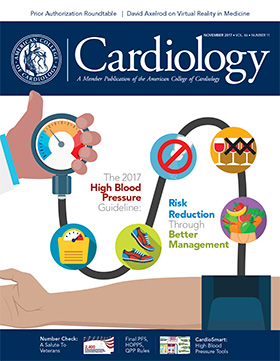Feature | Stakeholders Identify Pragmatic Solutions to Prior Authorization Process

While the rapid advance of new scientific developments and discoveries offer tremendous benefit to patients, many of these new discoveries are limited by the practical constraint of cost containment.
For more than a decade, payers have implemented prior authorization reviews to determine whether costlier health care services can move forward. However, providers and patients have found such regimens often to be time-consuming barriers to appropriate care.
Cardiology has not been immune from prior authorization frustrations. Groundbreaking cardiovascular pharmaceutical therapies have emerged over the last several years, including PCSK9 inhibtors and sacubitril/valsartan. Unfortunately, these therapies carry a prohibitively high price. A recent ACC survey showed that 78 percent of respondents consider prior authorization and the associated documentation a heavy administrative burden and one of the greatest barriers to providing the benefits of new therapies to patients. Moreover, less than one-third of patients prescribed a PCSK9 inhibitor received the medication due to low insurance approval rates and patient abandonment, according to a study recently published in JAMA Cardiology.
In an effort to address the needs of payers, health care providers, patients and pharmaceutical companies, the ACC recently brought together stakeholders from across the health care spectrum as part of its Prior Authorization: Right Drug, Right Patient For Cardiovascular Treatment Roundtable. The goal: to discuss pragmatic solutions to improve the prior authorization process as it pertains to prescribing cardiovascular medications.
Roundtable Co-Chairs Dharam J. Kumbhani, MD, FACC, and Lonny Reisman, MD, FACC, kicked off the day-long event by talking about the importance of having the “right treatment for the right patient at the right time.” They discussed the importance of understanding the views of all stakeholders involved in the prior authorization process and challenged participants to explore innovative ways to ease administrative burdens and streamline the process for all involved.
“It’s evident that the status quo is not working — having transparency in the process is appreciated by everyone and we need to work together to identify a common denominator that all stakeholders can use,” said Kumbhani.
Pamela B. Morris, MD, FACC, associate professor of medicine and director of the Seinsheimer Cardiovascular Program and co-director of women’s heart care at Medical University of South Carolina, was joined by Amita Dasmahapatra, MD, senior director of medical affairs at CVS Health, during an interactive discussion on “why prior authorization.” Morris and Dasmahapatra offered their perspectives as a provider and as a pharmacy benefits manager, respectively, on the need to define the goal of prior authorization — to stem overutilization or improve optimization?
"It’s the College’s hope that the Roundtable will shape pragmatic solutions that the ACC can leverage to inform the development of resources and tools to support effective prior authorization of cardiovascular drugs." — Richard J. Kovacs, MD, FACC
From there, participants discussed ways to streamline the documentation process; the value of qualitative vs. quantitative measures in prior authorization criteria; usefulness of the appeals process; appropriate use of step therapy; and more. Among the recommendations: a consistent feedback mechanism between payers and providers; better use of electronic health records (EHRs) to both manage patient data and streamline communication between clinicians and payers; and a transparent and consistent appeals process. Most participants felt that “step therapy” was appropriate when supported by medical evidence, but recognized the difficulties associated with patients who switch health care providers or payer in the middle of the process and are forced to start from the beginning. There was also a desire among clinicians for payers to use Appropriate Use Criteria, like those developed by the ACC, as part of their prior authorization process.
Alan Balch, PhD, CEO of the National Patient Advocate Foundation and the Patient Advocate Foundation, and Lauren Vela, MBA, senior director of member value for the Pacific Business Group on Health, tackled the many ways real-life complexity and costs impact prior authorization over both the short-term and the long-term. Their insights were followed by in-depth debate around whether patients can/should be partners in the prior authorization process and whether there are ways to determine patient costs before the process begins. The role of pharmacoeconomics, copays and deductibles, medical assistance programs and guidelines were also examined.
Overall, there was clear consensus that patients should be able to ascertain their out-of-pocket costs prior to the prior authorization process. Additionally, there was general agreement that costs cannot be separated from discussions of evidence and clinical care. Opinions, however, varied greatly regarding how and if patients should be involved in the prior authorization process.
Will data save the day, or are data another complication? Evan Grossman, vice president of integration services for athenahealth, and Luke Forster-Broten, MA, manager of product innovation at Surescripts, engaged with attendees on the topics of data use and role of EHRs, as well as the role of analytics and data acquisition. Their presentations focused on whether the prior authorization process could be integrated and automated using EHRs, allowing the prescribing physician and the pharmacy access. Additionally, Nicole Darden, from the ACC’s PINNACLE Registry team, provided an overview of how data registries could be leveraged to not only flag medications requiring prior authorization, but also to understand changes in cardiovascular care.
On the data front, there was general support for a mechanism where prescribing providers could become “certified” in prescribing select drugs and thus not required to seek prior authorization. The PINNACLE Registry and the Diabetes Collaborative Registry could collect the data to verify compliance.
There was also a collective desire to have prescription pricing easily available online for clinicians, as well as a notification when prior authorization is needed.
“The nature of this discussion is unique and hopefully this uniqueness will bring solutions,” noted Reisman during his closing remarks. He stressed the need for standardization, transparency and prior authorization throughout the prior authorization process. He also highlighted the need for an agreed-upon definition of cost-effective care.
Richard J. Kovacs, MD, FACC, chair of ACC’s Science and Quality Committee, said it’s the College’s hope that the Roundtable “will shape pragmatic solutions that the ACC can leverage to inform the development of resources and tools to support effective prior authorization of cardiovascular drugs.”
This Prior Authorization Roundtable was part of the Heart House Roundtables. It was supported by Amgen, Bristol-Myers Squibb, Pfizer, Janssen and Sanofi Regeneron.
Tweet this article: Tweet
|
Keywords: ACC Publications, Cardiology Magazine, Refusal to Treat, Deductibles and Coinsurance, Economics, Pharmaceutical, Frustration, Consensus, Cardiovascular Agents, Health Expenditures, Goals, Cost Control, Pharmaceutical Services, Pharmacies, Pharmacy, Electronic Health Records, Registries, Health Personnel, Documentation, Diabetes Mellitus
< Back to Listings


